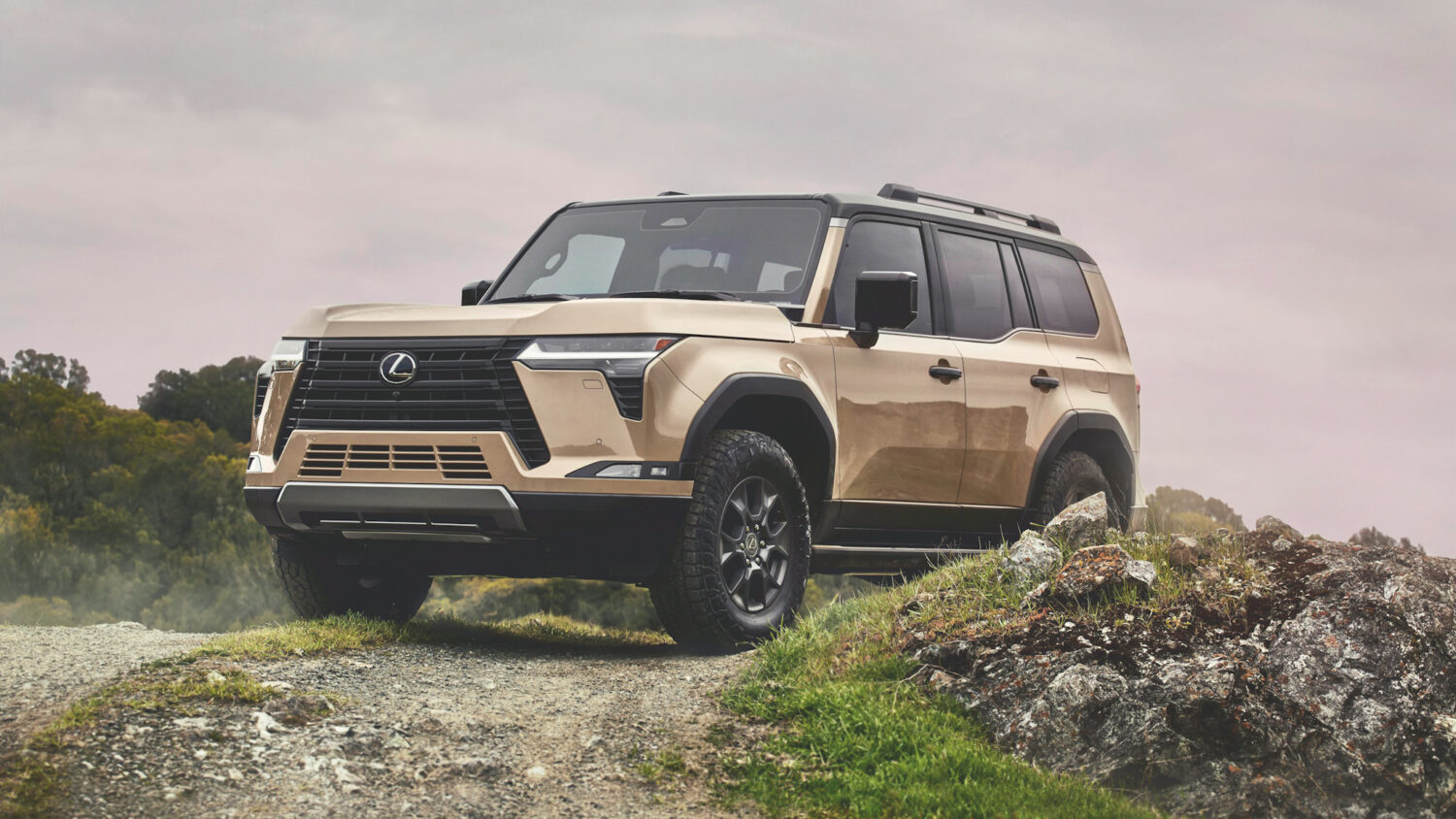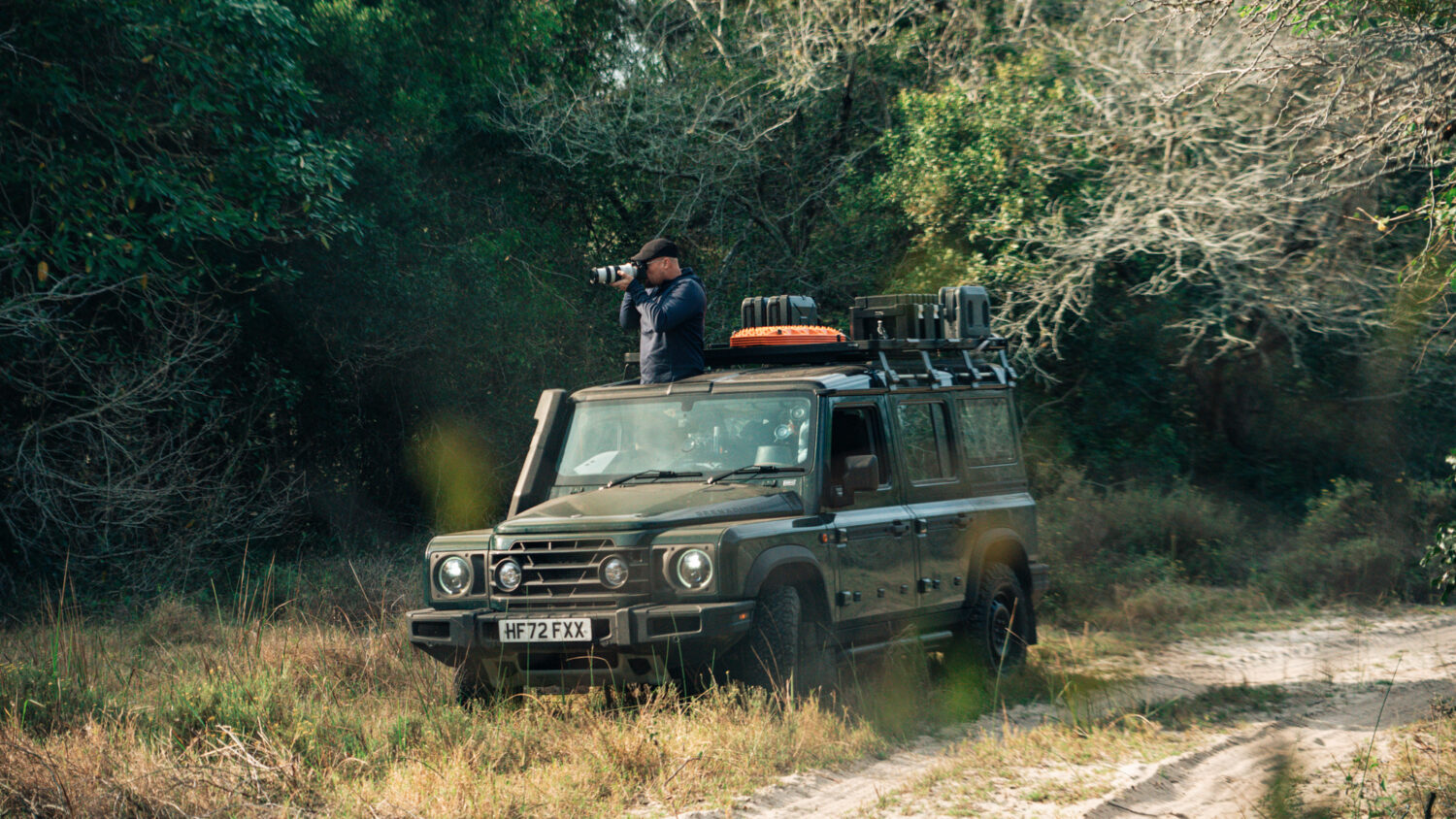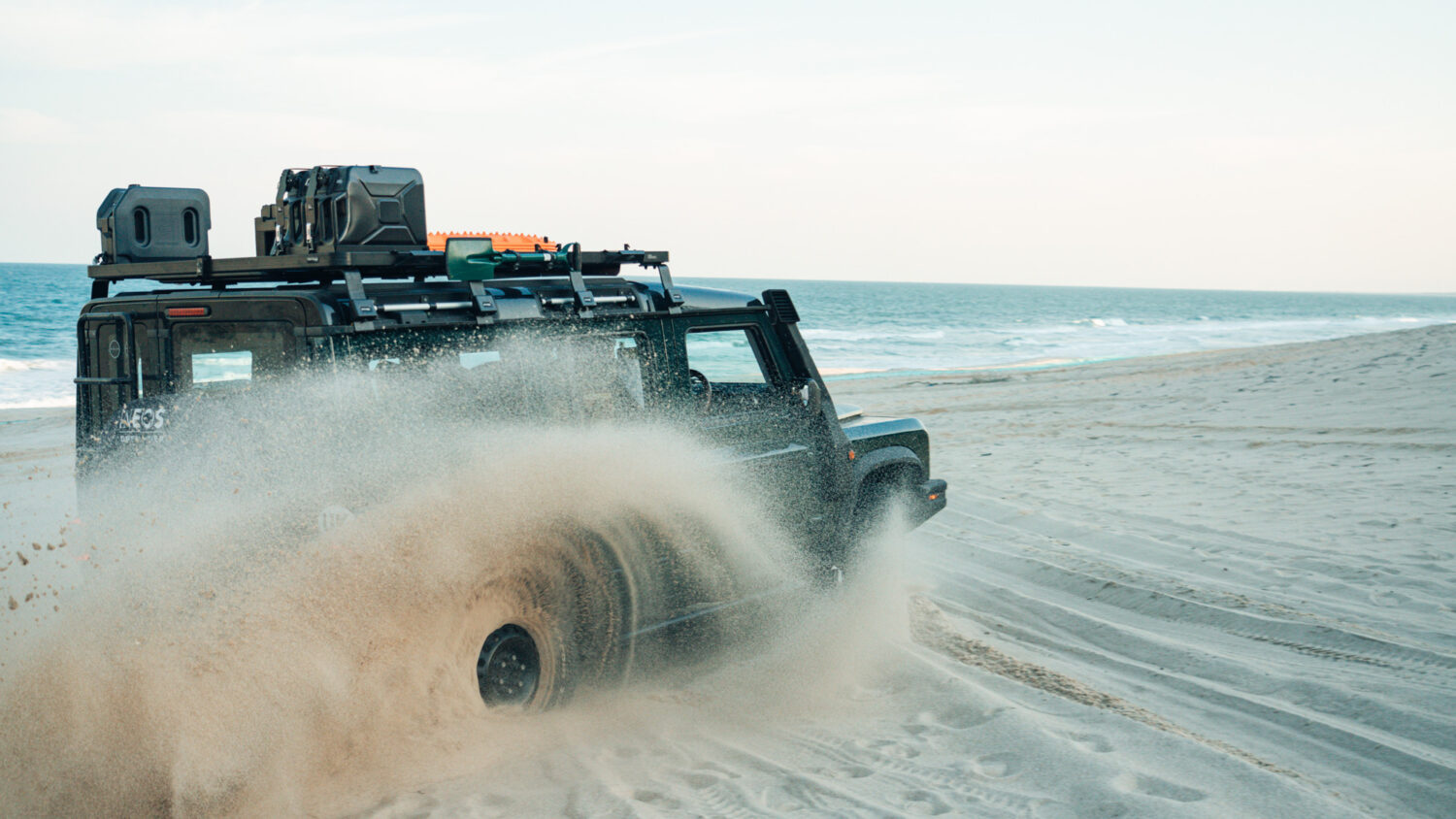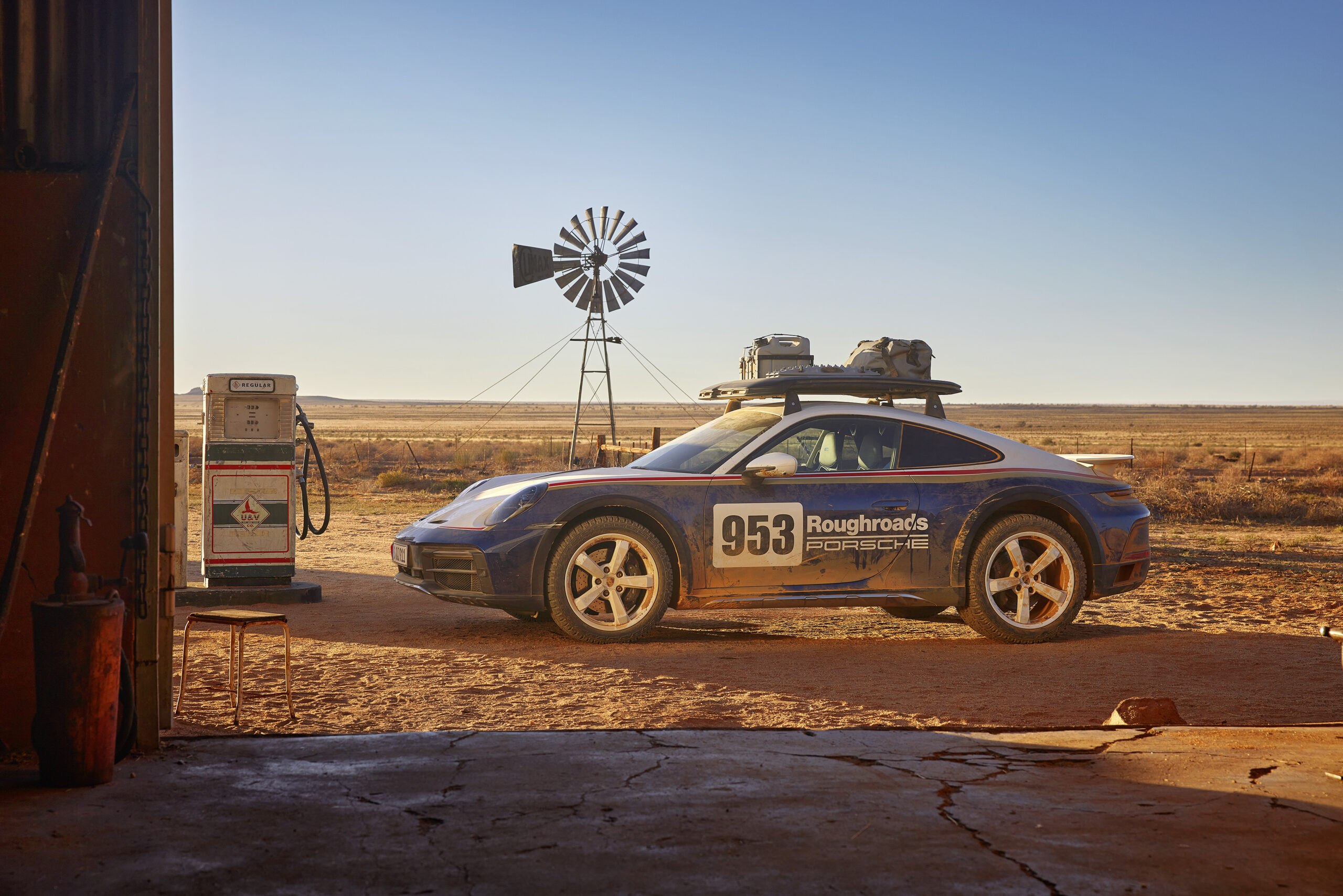The Lamborghini Huracán is a 630 horsepower, 3.2-seconds-to-60-mph rocket sled of a carbon fiber origami kit that is, by all accounts, an absolute joy to drive. The sounds the 5.2-liter V10 bellows from its hexagonal tailpipes many find worth the price of admission alone (MSRP $335,000). There is also an off-road version.
The Huracán Sterrato bumps the supercar’s ride height up by 44 millimeters, adds underbody protection, bespoke Bridgestone Dueler A/T rubber, and special tuning for its suspension and AWD system. Toss in a roof rack, auxiliary lighting, and a raised air intake (really), and—voila—you’ve got an all-weather, all-road monster that is simultaneously very, very silly and very, very cool.

Lamborghini Huracán Sterrato
Porsche has given the “safari” treatment to its flagship 911 sportscar with the Dakar model. The formula is the same—all-wheel-drive, revised dampers, boosted ride height (80 millimeters in this case), tough-looking body cladding, and aggressive tires. Because Porsche does what Porsche does, the $222,000 911 Dakar also is available with a vast range of accessories to complete the overland look (including a Porsche-branded roof rack, traction boards, and even a roof tent). While the Huracán Sterrato and the 911 Dakar are exceptional cases, they’re not as much of an outlier as you might expect.
- “Roughroads” livery evokes the Rothmans-sponsored Porsche rally cars of years past.
- Porsche-branded traction boards are optional.
Nearly every manufacturer that builds a vehicle with AWD or four-wheel-drive offers overland-oriented trims and accessories for their more pedestrian models. The knobby tire trend is permeating lineups across the industry, altering marketing strategies, research and development decisions, and engineering, and affecting a whole generation of new car buyers. What does this mean for the average consumer and the adventure-travel enthusiast?
Overlanding in the Driver’s Seat
Long on the fringes of the automotive world, the overland lifestyle and aesthetics have, without a doubt, reached the mainstream. The advent of #vanlife seven or eight years ago and its subsequent rise to fame during the global pandemic fueled much of this fascination with living a romantic life on the road and exploring off the tarmac in the wider reaches of the American West. Now that the OEMs have gotten involved (including the builders of Italian sports cars), we know that it has well and truly arrived. Auto manufacturers are slow-moving beasts, and vehicle engineering lead times stretch into years-long processes. When they choose to invest in particular lines of development, they see staying power in them.
Of course, turning sports cars into off-roaders is nothing new. The 911 Dakar is an homage to the Paris-Dakar-winning Porsche 911s and 959s of the 1980s (you can order your 911 Dakar with a classic Rothmans-themed race decal set). From Mini Coopers to Nissan Zs, the world’s rally stages have long been technical and marketing test beds for all kinds of manufacturers. But we have to thank Subaru and a briefly popular Australian comedy actor for popularizing the rugged, all-terrain life for the conventional car buyer.
The Outback and Beyond
Still something of a boutique brand in the mid-1990s, Subaru was slowly transitioning its small selection of sedans, sporty cars, and wagons to exclusively AWD drivetrains. The modestly powered and modestly priced Legacy, Impreza, and SVX were quirky and had limited appeal. The only other car-builder at the time hanging its hat on all-wheel-drive was Audi, and their lineup was priced in a much higher luxury bracket. The model that would launch Subaru from eccentric to established was the 1995-1996 Legacy Outback Wagon.

My old 1999 Subaru Legacy Outback was just one of several first-gen Outbacks I owned.
Built to gain a toe-hold in the exploding SUV market at the time, the original Outback’s blueprint today looks familiar: take a run-of-the-mill AWD station wagon, add ground clearance, a roof rack, some body cladding in a contrasting color, and a set of big fog lights set deep into the front bumper. Throw in a memorable marketing campaign featuring Crocodile Dundee star Paul Hogan ripping around the Australian wilderness, and the Outback became an overnight success. Subaru then applied the same treatment to its small Impreza wagon, as well as the Legacy sedan (dubbed the Sport Utility Sedan, or SUS). These Outback models proved to be solid off-road performers, given their relatively limited build sheets. With some success in the World Rally Championship cementing their off-piste credentials, Subaru never looked back.
While the Outback saved the six-starred brand in North America, others were relatively slow to catch on to the phenomenon. But over time, Subaru became one of the fastest-growing and profitable companies in the industry, due in no small part to going all in on AWD and its focus throughout the 2000s on the burgeoning market in outdoor adventure lifestyles. Subaru dealers were among the first to offer comprehensive accessory packages right in the showroom to support consumers’ active hobbies and pastimes, including special interior add-ons and roof rack attachments for skis, kayaks, and bikes.
All In Off Road
Fast-forward to the 2020s, and essentially every major auto manufacturer offers AWD versions of their cars, crossovers, and SUVs (once a novelty), not to mention more conventional 4×4 drivetrains. In addition, nearly all have introduced trims designed to appeal directly to the overland and adventure travel crowd. This includes not only the obvious brands like Land Rover, Ford, Jeep, GMC, Toyota, and Subaru but has also bled over into less obvious marks, like the Lamborghinis and Porsches of the world, as well as Honda, Lexus, and VW. Toyota debuted its long-awaited 4th generation Tacoma at Overland Expo last year, and the official Toyota press release introducing the Trailhunter version of their mid-size pickup shouted from the headline, “Overlanders Rejoice!”

The 2024 Toyota Tacoma Trailhunter dipping its toes in the overland waters.
The basic framework remains the same, but in recent years, we have also seen brands going far beyond mudflaps and simple ride height and bodywork changes in these models. These enhancements include major technical and mechanical upgrades, like advanced electronic drive modes, locking differentials, suspension upfits from outside suppliers like Bilstein, and active suspension technology, as well as steel or aluminum underbody and sill armor. Many of these options once were found solely in the off-road aftermarket realm and only for dedicated enthusiasts. Now they come right off the assembly line or are installed at your local dealer’s service department as special add-on packages.

The Lexus GX550 Overtrail is a Toyota Land Cruiser in disguise.

The Honda Ridgeline Trailsport adds ground clearance and beefed-up suspension to the run-of-the-mill Ridgeline.
The OEMs are also partnering with big names that we recognize in the overland aftermarket, like ARB, Dometic, Go Rhino, and Thule, to offer overland accessory packages on the showroom floor. In some cases, you can have camp chairs, portable solar panels, an auxiliary battery, a recovery kit, a fridge, a roof rack, an awning, and a roof tent all added to your new vehicle before you even drive off the lot. Tesla is selling a truck-bed tent for its new Cybertruck, and Rivian even tried to offer a fully kitted overland kitchen for the R1T pickup. Crucially, all of this optional gear can be wrapped right into your financing.

The Subaru Outback Wilderness, at 9.5 inches, has almost as much ground clearance as my original Land Rover Defender.
Furthermore, a very small handful of companies like American Expedition Vehicles (AEV) offer comprehensive off-road conversion packages for brand-new vehicles, like the JL-generation Wrangler, Chevy Colorado (ZR2 Bison), and Ram pickups (Prospector). You can order an AEV-converted truck directly from the dealer, and they are backed by the automaker’s factory warranty. Startup Ineos has engineered its Grenadier from the ground up as an overland-specific vehicle, ready to cross continents from the first turn of the key.

AEV RAM Prospector XL

The Ineos Grenadier has moved the goalposts for factory-built overland vehicles.
The Trail Ahead
The upshot is a modern bonanza for the overland and off-road enthusiast. If you’re in the market for a new adventure vehicle, never before has there been a wider selection of more capable rides on the market. As long as this trend continues, we’re bound to see even more brands jumping into the fray and leaning in with all the engineering resources and might that only big automakers can muster. For example, Hyundai and Kia have yet to debut models that hit the bullseye for the overlander; given their sales volume, the Santa Fe and the Telluride seem ripe for the treatment.
Some questions remain, however. Are consumers sold on more capability than these vehicles can actually deliver? Tough-looking but only marginally mechanically improved SUVs and pickups can be a trap for the uneducated and inexperienced driver on gnarlier topography. No matter how advanced the current batch of AWD systems are, their lighter-weight componentry (e.g., smaller, often gearless, differentials and thin axles) means they are still no match for traditional solid-axle 4×4 drivetrains when it comes to durability on rough tracks. The larger durability issue is also in play. While the capability curve may be on the upswing, will this new batch of factory overlanders stand the test of time with repeated hard all-terrain use?

Pinning down who and what these vehicles are actually for is also something of a chimera. While it’s nice to know the capability is there when needed, even the most dedicated wildland travelers among us still spend 90 percent of our driving time on paved roads and on trails that the most unpresuming crossover can dispatch with ease. A/T tires, rock-crawling bodywork, and increased weight add upfront costs and drag down fuel economy. My hometown in the mountains of Montana is beset with Wilderness-edition Outbacks and Crosstreks—and they look incredible (especially in Geyser Blue) parked at the grocery store. Is their margin of utility that much more than the standard models?
That question brings us back to the Huracán Sterrato and the 911 Dakar. A vehicle choice is as much an emotional one as it is a rational one. I won’t tut-tut the Outback Wilderness buyer any more than I would someone who plunks down the scratch for a quarter-million dollar Porsche with a lift. It’s good to admit that we might buy into something at a premium specifically because it looks cool or even because it’s a little bit silly. If it leads to amazing experiences behind the wheel, then it may be worth it. Utility isn’t always the necessary answer to the question, but it might be a sufficient one—to what degree is up to the driver.
Listen more:
Dave Harriton on the New Class of OEM Overland Vehicles :: Overland Journal Podcast
Crossing Africa with the Ineos Grenadier: South Africa and Mozambique :: Overland Journal Podcast
Watch more:
Will the Maverick Tremor Off-Road and Overland?
Ineos Grenadier Build for Crossing Africa: Detailed Walkaround Video
Images: Lamborghini, Porsche, Subaru, Honda, Lexus, Toyota, AEV, Stephan Edwards, Joe Fleming
Our No Compromise Clause: We do not accept advertorial content or allow advertising to influence our coverage, and our contributors are guaranteed editorial independence. Overland International may earn a small commission from affiliate links included in this article. We appreciate your support.




